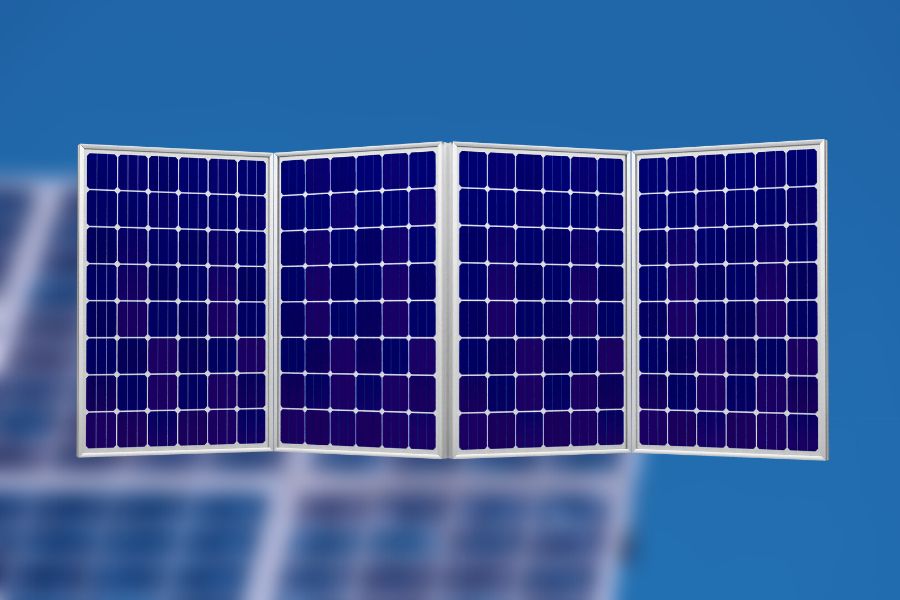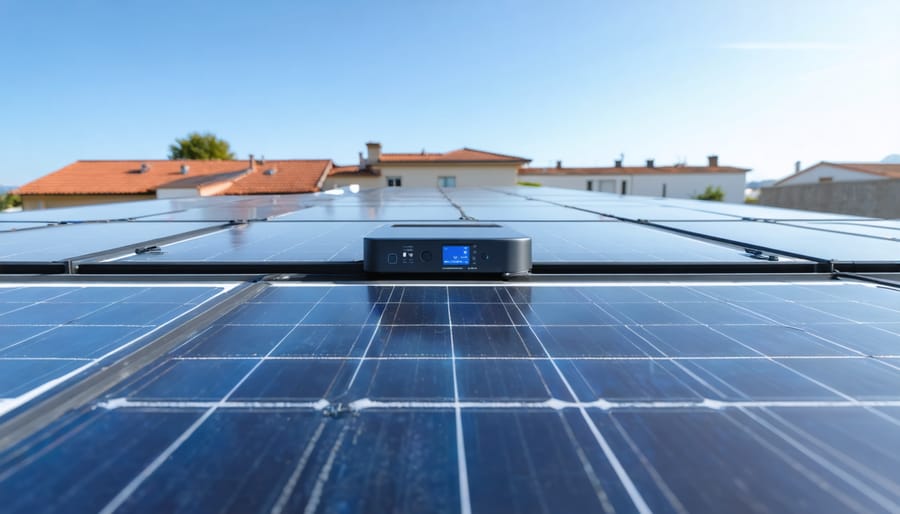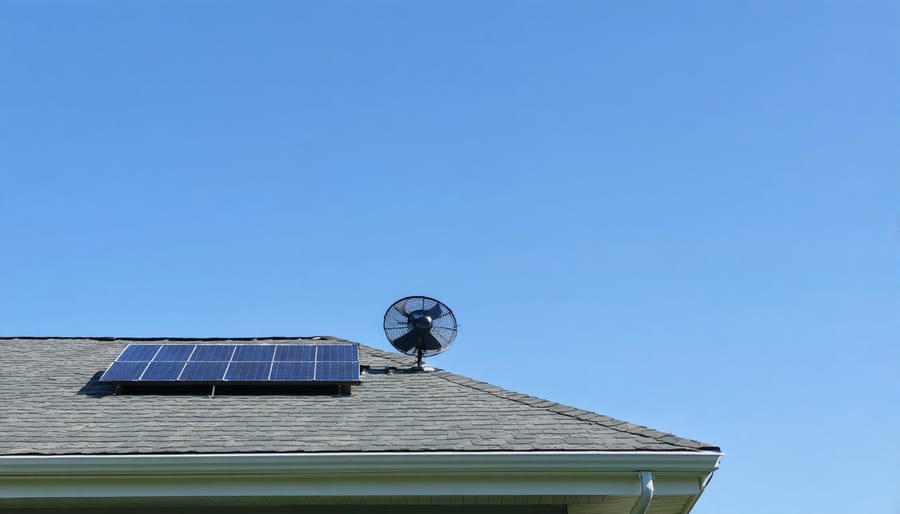Stop Guessing Your Battery Power: The Conversion Table Every Solar DIYer Needs
Updated:
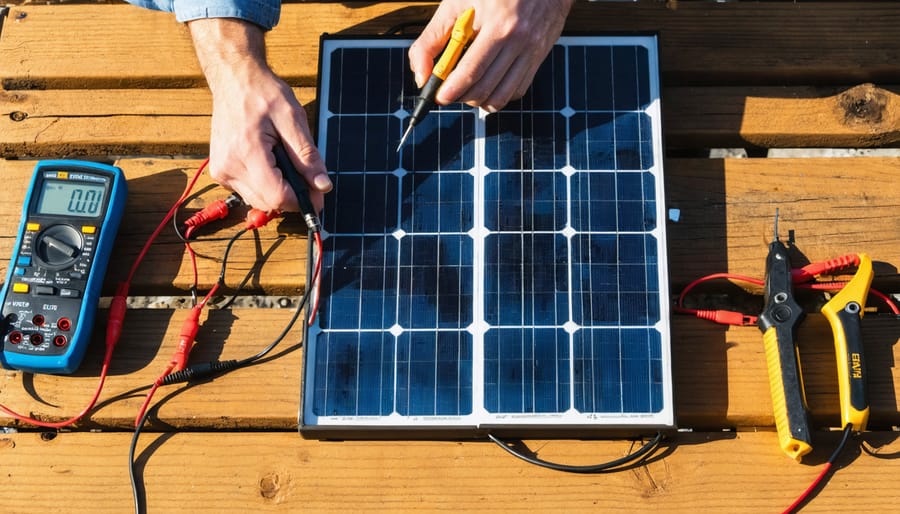
Grab your battery specifications and check three numbers that matter: amp-hours (Ah) tells you total capacity like a fuel tank size, watt-hours (Wh) reveals actual energy storage accounting for voltage differences, and reserve capacity (RC) shows real-world runtime at a steady draw. These measurements aren’t interchangeable labels for the same thing—they’re different windows into your battery’s capabilities, and mixing them up means undersizing your solar setup or overestimating your camping power supply.
I learned this the hard way during my first off-grid installation when I assumed a 100Ah battery would power my devices the same way regardless of voltage. My 12V system died hours earlier than expected because I hadn’t calculated the watt-hour reality: that same 100Ah delivers 1,200Wh at 12V but 2,400Wh at 24V. The amp-hour rating stayed identical, yet my actual available energy doubled with voltage changes.
**Converting between these measurements requires knowing your battery’s voltage.** Multiply amp-hours by voltage to get watt-hours (100Ah × 12V = 1,200Wh). For reserve capacity, divide RC minutes by 60, then multiply by 25 amps to approximate amp-hours, since RC measures how long a battery delivers 25A before dropping to 10.5V. A battery with 120 RC roughly equals 50Ah.
Understanding these conversions transforms vague specifications into actionable power planning. You’ll know exactly whether that marine battery matches your solar array’s output, if your lithium upgrade delivers equivalent runtime, or how many hours your camping fridge runs before depleting reserves. The table ahead simplifies these calculations, giving you instant translations between measurement systems without repetitive math—your shortcut from confusion to confident battery selection for any renewable energy project.
Why Battery Capacity Numbers Feel Like a Foreign Language
I remember standing in the battery aisle at my local hardware store a few years back, staring at what felt like hieroglyphics on different battery packages. One marine battery proudly displayed “105 Ah” on its label. Right next to it, another showed “1260 Wh.” A third had “205 minutes RC” stamped across the front. I needed a battery for my first solar setup, and I honestly had no idea which one would actually work better—or if they were even comparable.
If you’ve felt that same confusion, you’re absolutely not alone. This isn’t a “you” problem—it’s an industry problem that trips up even experienced DIYers.
Here’s why battery shopping feels like decoding a foreign language: manufacturers aren’t being deliberately confusing (well, mostly). They’re actually serving different markets that have historically cared about different things. Marine battery makers use Reserve Capacity (RC) because boaters need to know how long their electronics will run if the engine dies. RV manufacturers lean toward Amp-hours (Ah) because that’s the standard for 12V systems. Meanwhile, solar equipment companies often use Watt-hours (Wh) because it works across different voltages—crucial when you’re mixing 12V, 24V, and 48V components.
The frustrating part? There’s no universal standard requiring batteries to list all three measurements. So when you’re comparing a $200 battery from Brand A against a $180 battery from Brand B, you might literally be comparing apples to oranges without even realizing it.
This measurement maze becomes especially maddening when you’re trying to calculate how many batteries you need for a weekend camping trip or sizing a home solar bank. You need to compare products, but the numbers don’t match up. It’s like trying to convert between miles and kilometers in your head while driving—technically possible, but unnecessarily stressful.
The good news? Once you understand the basic conversion formulas, these confusing numbers suddenly become perfectly readable.
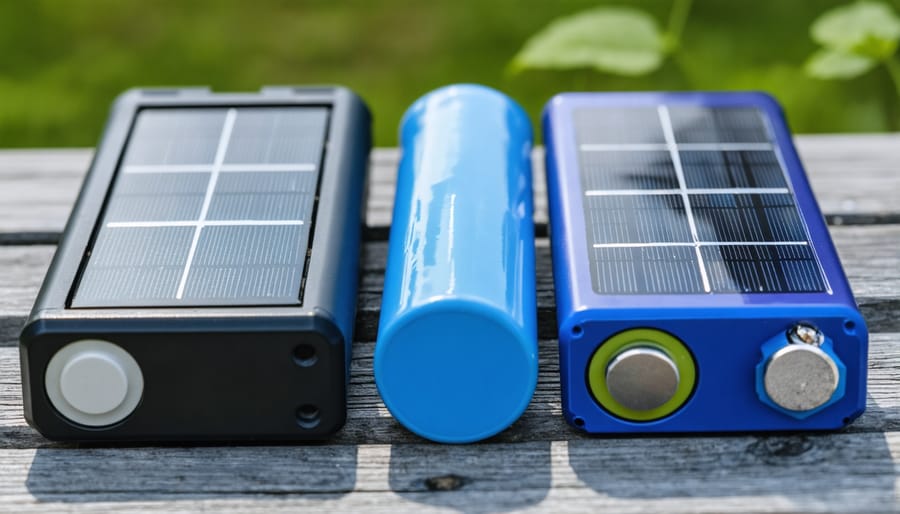
The Three Battery Capacity Measurements You’ll Actually Use

Amp-Hours (Ah): The Standard Everyone Uses
Amp-hours, or Ah, is the measurement you’ll see stamped on nearly every battery label—from the deep cycle batteries in your solar setup to the marine battery powering your trolling motor. Think of amp-hours as your battery’s fuel tank size. It tells you how much electrical current a battery can deliver over time before it needs recharging.
Here’s how it works in practical terms: a 100Ah battery can theoretically deliver 100 amps for one hour, or 10 amps for 10 hours, or 5 amps for 20 hours. You get the picture. It’s all about multiplication—amps times hours equals amp-hours.
I remember when I first started building my solar system, I made the rookie mistake of buying a battery that looked impressive but had only 35Ah capacity. I connected my small fridge, which drew about 3 amps, and wondered why my battery died after barely 8 hours instead of the 11 hours I calculated. That’s when I learned that real-world performance rarely matches the math perfectly—batteries discharge less efficiently at higher rates, and you shouldn’t drain them completely anyway.
Why is Ah the standard everyone uses? Simple—it’s universal and straightforward. Whether you’re comparing batteries at the hardware store or planning your off-grid cabin’s power needs, amp-hours give you an apples-to-apples comparison. Just multiply your device’s amp draw by how many hours you need it to run, and you’ll know what battery capacity you need.
Watt-Hours (Wh): What Your Devices Actually Care About
Here’s where things get practical—and honestly, this is the measurement I wish I’d paid more attention to when I started out. While amp-hours tell you about capacity, watt-hours (Wh) tell you about actual usable energy. Think of it this way: Wh answers the question “How much work can this battery actually do?”
Here’s what clicked for me during a camping trip: I had a 100Ah battery, but I couldn’t figure out how long it would run my laptop. That’s because my laptop’s power adapter lists watts, not amps. Watt-hours bridge that gap perfectly.
The formula is beautifully simple: **Wh = Ah × Voltage**. So a 100Ah 12V battery stores 1,200Wh of energy. That same battery could theoretically run a 100W device for 12 hours (though in reality, you’d get less due to efficiency losses and the 50% discharge rule we discussed earlier).
You’ll encounter watt-hours constantly with portable power stations—those handy battery boxes that have become essential for off-grid adventures. Manufacturers advertise them in Wh because it instantly tells you: “This 500Wh power station can charge your 50W laptop about 10 times.”
For solar DIYers, understanding Wh helps you match your battery bank to your actual power consumption. If your fridge uses 1,000Wh daily, you know exactly what battery capacity you need—no guesswork required. This measurement transforms batteries from mysterious boxes into predictable power partners.
Reserve Capacity (RC): The Automotive Oddball
If you’ve ever shopped for a car battery, you’ve probably seen “Reserve Capacity” listed on the label and wondered what the heck it means. Here’s the thing: RC is the automotive world’s quirky way of rating batteries, and it’s actually pretty useful when you’re working with surplus car batteries in solar projects—something I’ve done more times than I can count after finding great deals at salvage yards!
Reserve Capacity measures how many minutes a fully charged 12V battery can deliver 25 amps before dropping to 10.5 volts. Think of it as an endurance test. A battery with 100 RC can power a 25-amp load for 100 minutes straight. It’s less about total energy storage and more about staying power under moderate loads.
Why does this matter for your solar setup? Well, RC gives you a practical sense of how long that repurposed car battery will keep your lights on during cloudy days. However, converting RC to the amp-hours or watt-hours you’re used to isn’t perfectly straightforward since RC tests under specific conditions that might not match your actual usage.
As a rough guideline, you can estimate amp-hours by dividing RC by 2.4. So a battery rated at 120 RC would be roughly 50 Ah. It’s not exact, but it gets you in the ballpark when you’re evaluating whether that used battery is worth bringing home for your project. Just remember: car batteries aren’t designed for the deep cycling that solar systems demand, so they’ll wear out faster than proper deep-cycle batteries.
The Essential Battery Conversion Table (Bookmark This)
Let me be straight with you—I’ve fumbled around with battery specs more times than I’d like to admit during my early solar projects. Nothing’s more frustrating than staring at a battery label that lists reserve capacity when your solar charge controller needs amp-hours. That’s exactly why I created this go-to conversion table you can reference anytime.
**Common Battery Conversions at 12V**
For standard 12-volt systems (the most common in solar setups):
– 50Ah = 600Wh = approximately 100 minutes RC
– 100Ah = 1,200Wh = approximately 200 minutes RC
– 200Ah = 2,400Wh = approximately 400 minutes RC
**Conversions for 24V Systems**
If you’re running a 24-volt configuration:
– 50Ah = 1,200Wh = approximately 200 minutes RC
– 100Ah = 2,400Wh = approximately 400 minutes RC
– 200Ah = 4,800Wh = approximately 800 minutes RC
**Conversions for 48V Systems**
For larger 48-volt installations:
– 50Ah = 2,400Wh = approximately 400 minutes RC
– 100Ah = 4,800Wh = approximately 800 minutes RC
– 200Ah = 9,600Wh = approximately 1,600 minutes RC
**Real-World Examples**
Let’s make this practical. That portable camping battery rated at 100Ah and 12V? You’re looking at 1,200 watt-hours of storage—enough to run a small refrigerator for about 12-15 hours. Your weekend camping trip just got a whole lot easier to plan.
For home solar backup, a 200Ah battery bank at 48V gives you 9,600Wh. That’s enough juice to keep your essentials running—router, LED lights, laptop, and even a small fridge—through an entire evening blackout.
I remember trying to match a marine battery to my solar panel output and getting completely lost in the numbers. Having these conversions handy would’ve saved me hours of head-scratching.
**Need a Custom Conversion?**
Here’s the thing—batteries don’t always come in these neat, round numbers. Maybe you’ve got an odd 73Ah battery or you’re working with a unique voltage. That’s where our battery capacity calculator comes in super handy. Just plug in your numbers and get instant conversions for your specific setup. I use it constantly when sourcing batteries from different manufacturers who insist on using different rating systems. Bookmark both this table and that calculator—they’re tools you’ll reference again and again.
How to Convert Battery Capacity in Three Simple Steps
Converting Amp-Hours to Watt-Hours (And Back Again)
Understanding how to convert between amp-hours (Ah) and watt-hours (Wh) is essential for matching batteries to your solar setup. The good news? It’s simpler than you might think!
**The Basic Formula**
To convert amp-hours to watt-hours, multiply by voltage:
**Watt-hours (Wh) = Amp-hours (Ah) × Voltage (V)**
Going the other direction is just as easy:
**Amp-hours (Ah) = Watt-hours (Wh) ÷ Voltage (V)**
**Real-World Example: Charles’s Van Battery**
When I was building out my camper van, I needed to figure out the actual capacity of my 100Ah 12V deep-cycle battery. Using our amp-hours to watt-hours calculator, here’s what I discovered:
100Ah × 12V = 1,200Wh
That meant my battery could theoretically power a 100-watt fan for 12 hours, or my 60-watt laptop for 20 hours. This calculation completely changed how I planned my electrical system!
**More Practice Examples**
– 50Ah at 24V = 1,200Wh (same capacity as my 100Ah 12V battery!)
– 200Ah at 12V = 2,400Wh
– Converting back: 600Wh ÷ 12V = 50Ah
**Why Voltage Matters**
Notice how a 50Ah battery at 24V stores the same energy as a 100Ah battery at 12V? That’s why you can’t compare amp-hour ratings alone—voltage is crucial! Always consider both numbers when sizing your system.
Need to work backwards? Our watt-hours to amp-hours tool makes reverse conversions effortless.
Turning Reserve Capacity Into Something Useful
If you’ve ever looked at an old car battery sitting in your garage and wondered if it could power your solar setup, understanding Reserve Capacity is your first step. RC measures how long a battery can deliver 25 amps before dropping to 10.5 volts—a rating that’s super common on automotive batteries but not directly useful for solar applications.
Here’s the good news: converting RC to amp-hours is straightforward. The general formula is **Ah ≈ RC × 0.6**. So if you have a battery with 120 minutes of reserve capacity, you’re looking at roughly 72 amp-hours (120 × 0.6 = 72 Ah).
I remember when my neighbor Charles repurposed his old truck battery for a small solar backup system. His battery showed 90 RC, which translated to about 54 Ah—perfect for running his workshop lights during evening projects. The beauty of this conversion is it helps you quickly assess whether that spare automotive battery is worth integrating into your renewable energy plans.
Keep in mind this is an approximation. Automotive batteries are designed for quick bursts of power, not the deep-cycle demands of solar systems, but for temporary backup or starter projects, they can absolutely work in a pinch.
Accounting for Battery Voltage in Your Conversions
Voltage is the unsung hero of battery conversions—ignore it, and your calculations will lead you astray every time. I learned this the hard way when I first started my solar journey. I confidently calculated my battery capacity in amp-hours, built my entire system around those numbers, and then wondered why everything felt “off.” Turns out, I’d mixed up calculations from my 12V car battery with my new 24V solar setup!
Here’s the key principle: amp-hours (Ah) measure capacity, but watt-hours (Wh) account for both capacity and voltage. To convert between them, you need to know your system voltage. The formula is simple: **Wh = Ah × Voltage**.
For example, a 100Ah battery gives you:
– 1,200Wh at 12V (most car and small solar systems)
– 2,400Wh at 24V (mid-size solar installations)
– 4,800Wh at 48V (larger home systems)
That’s the same physical battery providing wildly different usable energy!
**Common mistakes to avoid:** Never assume all batteries are 12V. Always confirm your system voltage before converting. And remember—when connecting batteries in series, voltages add up (two 12V batteries = 24V system), but capacity stays the same. In parallel connections, voltage stays constant while capacity increases.
Understanding this voltage relationship transforms you from someone who just follows instructions to someone who truly gets how their system works.
Real-World Conversion Scenarios for Solar DIYers
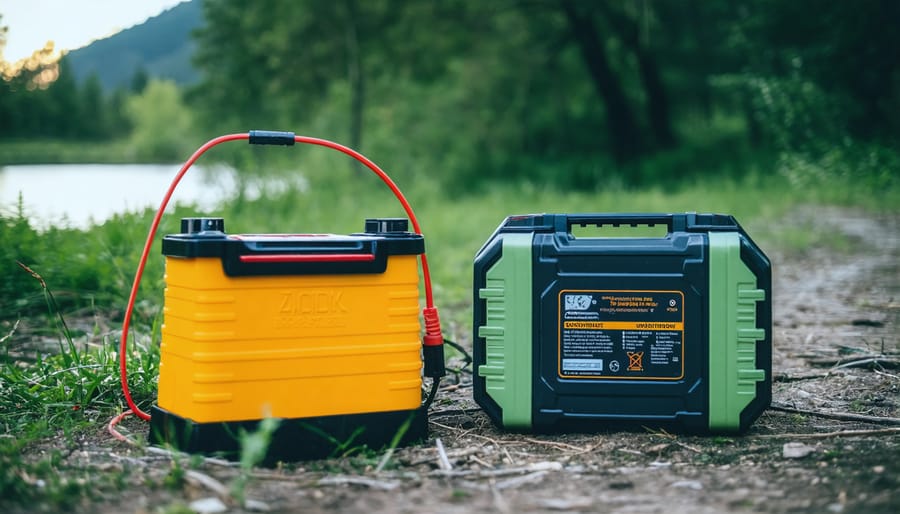
Sizing Your Solar Battery Bank for Off-Grid Camping
Let me walk you through a real camping scenario I’ve used countless times. Imagine you’re planning a weekend off-grid trip and need to power a few essentials: LED lights (10W), a phone charger (10W), and a small 12V cooler (40W).
First, estimate your daily usage hours. Let’s say lights run 4 hours nightly, your phone charges 2 hours daily, and the cooler runs 8 hours. That’s 40Wh + 20Wh + 320Wh = 380Wh per day.
For a two-day trip, you’ll need 760Wh minimum. Now here’s where conversion helps: if you’re buying a 12V battery, divide 760Wh by 12V to get 63.3Ah. I always recommend adding 20% buffer for efficiency losses, bringing you to roughly 76Ah needed.
Using our conversion table, you’d want at least a 100Ah deep-cycle battery to comfortably handle this load. Remember, you shouldn’t fully discharge most batteries—keeping them above 50% extends their lifespan significantly.
Want to know how long your solar panel takes to recharge? Check out our battery charge time calculator to plan your charging schedule between adventures.
Matching Batteries to Your Solar Panel Output
Getting your battery bank matched to your solar setup is crucial for system longevity. I learned this the hard way when my first DIY system kept undercharging because I hadn’t done the math properly!
Here’s the straightforward approach: First, calculate your solar panel’s daily energy production. If you have a 100W panel getting 5 hours of good sunlight, that’s 500Wh per day. Now convert this to amp-hours at your battery voltage—for a 12V system, divide 500Wh by 12V to get roughly 42Ah of daily charging capacity.
Your battery bank should ideally store 3-5 days of energy use, but it also needs to accept the charging current comfortably. Most batteries can safely accept a charge rate of about C/10 (10% of their capacity). So a 100Ah battery can handle 10A charging current.
Use our conversion table to ensure your solar panel charging capacity matches your battery’s acceptance rate. Converting between Wh and Ah at different voltages helps you see the complete picture and avoid mismatched components that waste energy or damage batteries.
Comparing Different Battery Types Apples-to-Apples
Here’s where conversion tables become incredibly practical—when you’re trying to decide between different battery types for your solar setup. I remember standing in a store last year, comparing a 100Ah lithium battery against a 200Ah AGM, both priced similarly, and feeling completely confused about which was actually the better deal.
The trick is converting everything to the same unit—I recommend watt-hours (Wh) since it gives you the full picture of usable energy. That 100Ah lithium battery at 12V gives you 1,200Wh (100 × 12). But here’s the game-changer: lithium batteries can typically discharge to 80-90% of their capacity safely, giving you around 1,080Wh of usable energy.
The 200Ah AGM, also at 12V, seems like 2,400Wh—twice as much! But AGM batteries should only discharge to about 50% to maintain their lifespan. So you’re really working with just 1,200Wh usable.
Suddenly, those batteries are nearly equivalent in practical use, but the lithium weighs half as much and lasts 3-4 times longer. Using our conversion table to calculate true usable capacity levels the playing field and helps you make smarter purchasing decisions based on your actual needs rather than just the numbers on the label.
Common Conversion Mistakes (And How I Learned From Them)
I’ll be honest with you—my first solar setup nearly ended in disaster because I completely misjudged my battery capacity. I was so excited about my new 100Ah battery that I assumed I had 100Ah of usable power. Wrong! That mistake taught me lessons I want to share so you don’t make the same errors.
**The Usable Capacity Trap**
Here’s the big one that catches almost everyone: thinking your battery’s rated capacity equals what you can actually use. When I built my first camping power station, I calculated that my 200Ah lead-acid battery would run my equipment for days. Reality hit hard when my battery died much sooner than expected. I’d forgotten about depth of discharge (DoD) limits.
Lead-acid batteries should typically only be discharged to 50% to maintain longevity. That means my 200Ah battery really only gave me 100Ah of usable capacity. LiFePO4 batteries are better—you can safely use 80-90%—but you still can’t drain them completely. Always multiply your rated capacity by your safe DoD percentage before planning your power needs.
**Mixing Up Wh and Ah**
Another common pitfall? Converting between watt-hours and amp-hours without accounting for voltage. I once ordered a battery thinking it would match my existing setup, only to realize I’d confused a 12V 100Ah rating with actual watt-hours. Remember: Wh = Ah × Voltage. A 100Ah battery at 12V gives you 1,200Wh, but that same 100Ah at 24V would be 2,400Wh. Always check both the amp-hours AND the voltage.
**My Simple Verification Checks**
Now I always run these quick tests on my conversions:
First, does my answer make sense? If you’re converting 50Ah at 12V to watt-hours and get 6,000Wh, something’s wrong (it should be 600Wh).
Second, I work backwards. If you calculated that you need a 150Ah battery, convert that back to watt-hours and then to your actual daily usage in watts. Does it still match your appliances’ requirements?
Finally, I add a 20% safety buffer to all my calculations. Batteries don’t perform perfectly in cold weather, and efficiency losses happen. This buffer has saved my projects countless times.
Quick Reference: Your Conversion Cheat Sheet
Alright, let’s bring everything together into one handy reference you can print out and stick on your workshop wall! I keep a laminated version of this right next to my workbench, and it’s saved me from pulling out my phone with greasy fingers more times than I can count.
**Essential Conversion Formulas:**
• **Amp-hours to Watt-hours:** Wh = Ah × Voltage
• **Watt-hours to Amp-hours:** Ah = Wh ÷ Voltage
• **Reserve Capacity to Amp-hours:** Ah ≈ (RC × 0.6)
• **Amp-hours to Reserve Capacity:** RC ≈ (Ah ÷ 0.6)
**Quick Multiplication Factors:**
For 12V systems (most common):
– 100Ah = 1,200Wh
– 1Wh = 0.083Ah
– Quick estimate: multiply Ah by 12 for Wh
For 24V systems:
– 100Ah = 2,400Wh
– Multiply Ah by 24 for Wh
**When to Use Each Measurement:**
**Amp-hours (Ah):** Use when comparing battery capacity directly, calculating how long batteries will run DC appliances, or sizing battery banks for solar systems.
**Watt-hours (Wh):** Best for figuring out total energy storage, comparing different voltage batteries, or calculating how long AC appliances will run with an inverter.
**Reserve Capacity (RC):** Mainly for automotive applications and understanding how long a battery can sustain minimal loads during emergencies.
**Pro tip from experience:** Always round down your final calculations by 10-15% to account for efficiency losses and battery aging. Real-world performance rarely matches the spec sheet perfectly, and building in this buffer has prevented countless headaches in my projects. Print this section out, and you’ll never second-guess your battery math again!
I’ll be honest with you—when I first started working with solar batteries for my off-grid cabin project, all these conversion formulas made my head spin. Amp-hours, watt-hours, reserve capacity… it felt like learning a foreign language. But here’s what I discovered: like any new skill, battery capacity conversions become second nature with practice. What once required a calculator and five minutes of double-checking now takes me seconds.
The beauty of having a reliable conversion table and calculator tools at your fingertips is that you don’t need to memorize every formula. Bookmark this page, keep it handy on your phone, and reference it whenever you’re planning a project or shopping for batteries. There’s absolutely no shame in checking your work—even experienced DIYers do it!
I’d love to hear about your own battery conversion challenges or solar projects. What are you building? Are you sizing a system for weekend camping trips, or planning something more ambitious like a full backup power setup? Drop your questions in the comments below. Our community thrives when we share experiences and learn from each other’s successes (and occasional mishaps—trust me, I’ve had plenty).
Here’s the empowering truth: mastering these basic conversions is your gateway to tackling more complex solar projects with confidence. Once you understand how to calculate battery capacity and match it to your energy needs, you’re no longer at the mercy of salespeople or confusing product specifications. You become the expert on your own system. That knowledge transforms you from someone who hopes their solar setup will work into someone who knows it will work—because you designed it right from the start.








